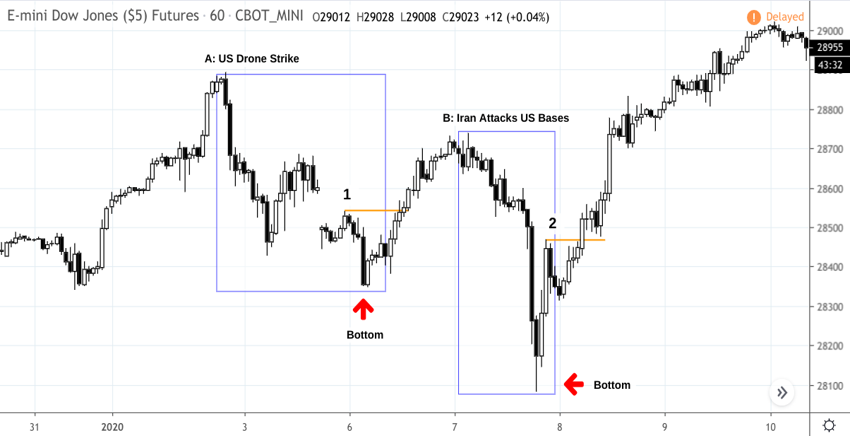In the first two weeks of 2020, hostilities between the US and Iran quickly escalated to what many feared would result in an all-out war:
- On January 3, President Trump ordered a drone strike that killed Iran’s top general, Qasem Soleimani.
- In the following week, on January 8, Iran retaliated with several missile strikes targeting two US military bases in Iraq.
Each event was followed by a swift market response, with US indexes falling and crude oil rising sharply out of fear that tensions between the two nations would escalate into war. But in a matter of days (particularly after it was announced that Iran had warned the bases hours before the attack, resulting in no US casualties), many investors shrugged off the events, and the stock market continued its rally.
So, the question that traders are asking is: What were the key signs to re-enter the market, and at what levels might re-entry be perceived to be safest?
Did the Event Change the Fundamentals?
Perhaps the biggest question to ask after a geopolitical market shock occurs is whether or not the event changed the fundamentals of the market. Short of any declarations of war, massive troop buildup, or disruptions of oil shipments in the Strait of Hormuz, there would be little evidence to warn that a major fundamental disruption was about to occur.
So, if the market didn’t plunge based on fundamentals, then it almost certainly plunged due to investor sentiment. And when this happens, particularly in the course of a strong bull market, market declines may present favorable “long side” opportunities.
Re-Entering the Markets via Dow Jones Futures Index

Dow Jones Futures (YM) 1-Hour Chart – December 20, 2019 to January 10, 2020
Looking at the chart above, we can view the two events and subsequent market responses: the US drone strike [A], and Iran’s response [B]. Looking at the drone strike, when the bottom occurred (see red arrow), there was no way to tell that it was indeed the bottom. Remember, the world was waiting for Iran’s response.
But some traders or investors jumped in nevertheless, causing the Dow to advance. A safer entry point might have been at the break out of the last swing high [1]. A break beyond this level would show, at the least, that a solid downtrend formation was questionable.
Iran’s response came a few days later, and we can see the market fall below the previous low. At this point, traders who jumped in on the long side might have had doubts that the US would commit itself to a longer and more protracted combat engagement. Plus, there was no indication that the global oil supply was officially under threat.
At the same time, you don’t want to catch a “falling knife.” So, similar to the last example, waiting for a break out of the last high [2] may have been perceived to be a safer entry. Also consider that placing a stop loss at the most recent low could potentially reduce your risk if you decided to enter there.
The Bottom Line
If you suspect that a market plunge is a correction, you don’t want to catch a falling knife. Remember, a down trend can be defined as consecutively lower lows and lower highs. So if a high is breached, then the down trend may be in question. So the safest entry point is arguably at a breakout of the high, as such an event would break the standard formation of the plunge.
But more importantly, when markets fall on geopolitical shocks, you should always ask yourself whether the fundamental situation is going to be redrawn. Is the market falling on sentiment or fundamentals? If it’s falling on sentiment, then the decline is likely a correction–the Wall of Worry that tends to shake out weak-handed market participants.
Please be aware that the content of this blog is based upon the opinions and research of GFF Brokers and its staff and should not be treated as trade recommendations. There is a substantial risk of loss in trading futures, options and forex. Past performance is not necessarily indicative of future results.
Be advised that there are instances in which stop losses may not trigger. In cases where the market is illiquid–either no buyers or no sellers–or in cases of electronic disruptions, stop losses can fail. And although stop losses can be considered a risk management (loss management) strategy, their function can never be completely guaranteed.
Disclaimer Regarding Hypothetical Performance Results: HYPOTHETICAL PERFORMANCE RESULTS HAVE MANY INHERENT LIMITATIONS, SOME OF WHICH ARE DESCRIBED BELOW. NO REPRESENTATION IS BEING MADE THAT ANY ACCOUNT WILL OR IS LIKELY TO ACHIEVE PROFITS OR LOSSES SIMILAR TO THOSE SHOWN. IN FACT, THERE ARE FREQUENTLY SHARP DIFFERENCES BETWEEN HYPOTHETICAL PERFORMANCE RESULTS AND THE ACTUAL RESULTS SUBSEQUENTLY ACHIEVED BY ANY PARTICULAR TRADING PROGRAM.
ONE OF THE LIMITATIONS OF HYPOTHETICAL PERFORMANCE RESULTS IS THAT THEY ARE GENERALLY PREPARED WITH THE BENEFIT OF HINDSIGHT. IN ADDITION, HYPOTHETICAL TRADING DOES NOT INVOLVE FINANCIAL RISK, AND NO HYPOTHETICAL TRADING RECORD CAN COMPLETELY ACCOUNT FOR THE IMPACT OF FINANCIAL RISK IN ACTUAL TRADING. FOR EXAMPLE, THE ABILITY TO WITHSTAND LOSSES OR TO ADHERE TO A PARTICULAR TRADING PROGRAM IN SPITE OF TRADING LOSSES ARE MATERIAL POINTS WHICH CAN ALSO ADVERSELY AFFECT ACTUAL TRADING RESULTS. THERE ARE NUMEROUS OTHER FACTORS RELATED TO THE MARKETS IN GENERAL OR TO THE IMPLEMENTATION OF ANY SPECIFIC TRADING PROGRAM WHICH CANNOT BE FULLY ACCOUNTED FOR IN THE PREPARATION OF HYPOTHETICAL PERFORMANCE RESULTS AND ALL OF WHICH CAN ADVERSELY AFFECT ACTUAL TRADING RESULTS.